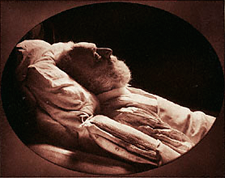{ excerpt }
I would never recognize Death (in the photograph or anywhere else) if I did not believe it existed. Nor would I identify a dead body or a mass grave – not even if a saw it with my own eyes.
The reality in both a analog and digital photography should of course be scrutinized – photography is not a mechanism that reveal reality. What we see through the photographic lense only mirrors our concepts of what could be and what we perceive as possibilities of reality.
We might want to remind ourselves of Nabokov and his mentioning of taboos 12 when we look at a photography of the ultimate atheist: Dying at 106 after a good and meaningful life. Could such a photography be recognized by the Catholic Church? It does not really matter if such lifes exists. The imperative is our willingness to except the possibility – That such a thing could be of reality. If we except it as plausible we could recognize it.

Victor Hugo on his Deathbed, 1885 CE
12 Vladimir Nabokov – Lolita, in the afterword, p. 259 (Norwegian edition). Nabokov writes about absolute taboos among american publishers at the time he tried to publish Lolita. The topics he mentions are of course the topic of the book itself and two others: a black and white marriage as a full blown and absolute success with multiple children and grandchildren and the above mentioned athiest.

 2011 - 2012
2011 - 2012